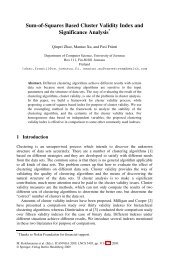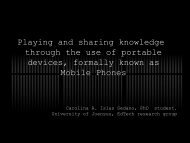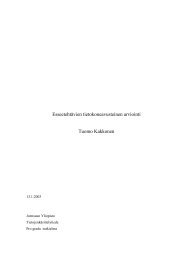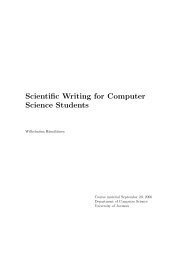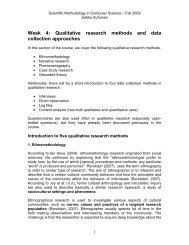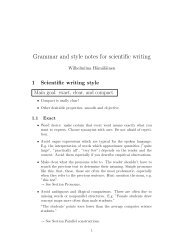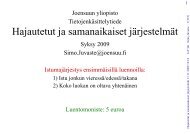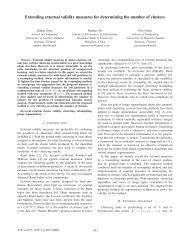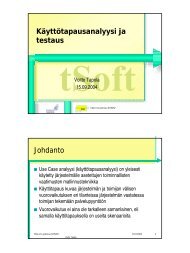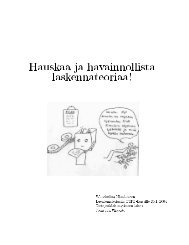Class NP, NP-complete, and NP-hard problems
Class NP, NP-complete, and NP-hard problems
Class NP, NP-complete, and NP-hard problems
Create successful ePaper yourself
Turn your PDF publications into a flip-book with our unique Google optimized e-Paper software.
<strong>Class</strong> <strong>NP</strong> , <strong>NP</strong> -<strong>complete</strong>, <strong>and</strong> <strong>NP</strong> -<strong>hard</strong><strong>problems</strong>W. HämäläinenNovember 6, 20061 <strong>Class</strong> <strong>NP</strong><strong>Class</strong> <strong>NP</strong> contains all computational <strong>problems</strong> such that the correspondingdecision problem can be solved in a polynomial time by anondeterministic Turing machine.I.e. <strong>NP</strong> is a time complexity class which contains a set of <strong>problems</strong>. Weshould just define what are• corresponding decision <strong>problems</strong>,• a non-deterministic Turing machine, <strong>and</strong>• the time requirement of a Turing machine.1.1 Computational <strong>problems</strong> <strong>and</strong> corresponding decision<strong>problems</strong>Any problem which in principle can be modelled to be solved by a computer,is called a computational problem. Examples of computational <strong>problems</strong> are:• Calculate the answer of an arithmetic expression e.• Sort customers’ names into alphabetic order.• Given a map of cities <strong>and</strong> roads, search the shortest route which goesthrough all cities exactly once <strong>and</strong> returns to the starting point, if suchexists.1
Non-computational <strong>problems</strong> cannot be solved by a computer or by anymechanical means. They are often related philosophy, ethics, or emotions.For example,• What is the meaning of life?• Is it right to eat meat on Fridays?• Phantom <strong>and</strong> Batman are fighting. Who wins?In computer science, we consider only computational <strong>problems</strong>.For any computational problem, we can inevent at least one related decisionproblem. The decision problem can have only answers ”yes” or”no”. For example, the following decision <strong>problems</strong> correspond the previouscomputational <strong>problems</strong>:• Given an arithmetic expression e <strong>and</strong> some number x, is x the solutionof e?• Given a list of customers’ names, are they in an alphabetic order?• Given a map of cities <strong>and</strong> roads, does it contain a route which goesthrough all cities exactly once <strong>and</strong> is at most 50 km?Such decision <strong>problems</strong> can be used to estimate the difficulty of the originalproblem. If the corresponding decision problem requires exponentialtime, the original problem cannot be solved any faster, <strong>and</strong> it is also (atleast) exponential. The goal is to invent such a decision problem which measuresthe difficulty of the original problem as well as possible (i.e. has thesame difficulty).1.2 Non-deterministic Turing machinesA Turing machine is an abstract model of computation. According to Church-Turing thesis, any problem which can be solved by a computer can be solvedby a Turing machine. (Note that this is only a thesis, <strong>and</strong> nobody has beenable to prove it universally true, but it is widely believed to be true.) Thismeans that we can use Turing machines to find out whether a problem issolvable or not. If we can solve it by a Turing machine which halts by allinputs, then the problem is solvable, <strong>and</strong> otherwise unsolvable. In addition,Turing machines can be used to estimate how difficult a problem is or whatis its time or space complexity. For example, if a problem requires a Turingmachine which runs in exponential time, we cannot invent a Java program2
which would solve the problem in a polynomial time. The benefit of Turingmachines is that they hide all implementation details <strong>and</strong> it is easier to makeproofs <strong>and</strong> analyze the complexity of <strong>problems</strong>.Turing machines are divided into two main types: deterministic <strong>and</strong> nondeterministic.A deterministic machine is like a state machine which readsthe input character by character <strong>and</strong> enters to the next state according to thecurrent state <strong>and</strong> the read character. In the same time, it writes a characterto the tape <strong>and</strong> moves its reading-writing head to the right or left. Thismeans that the functionality of the machine is fully determined by thecurrent state <strong>and</strong> the currently read character. The computation pathis always one sequence of states with any input (from the beginning state tothe final state).A non-deterministic Turing machine works otherwise like a deterministicmachine, but it can have states where there are several alternative successorstates, given the same input character. This means that the computationis not a direct path, but contains branches (it is like a tree with severalpaths from the same beginning state to final states). The macine alwaysselects the ”correct” alternative among possible successor states. I.e. if thereis at least one possible path which leads to the accepting final state, the machineaccepts the input (answers ”yes”), <strong>and</strong> otherwise it rejects it (answers”no”). You can imagine that the non-deterministic machine has power to”guess” the correct path or that it simulates all possible (direct) computationpaths simultaneuosly <strong>and</strong> selects the best one. (If we want to implementa non-deterministic Turing machine as a computer program, we really haveto simulate all possible computations with that input <strong>and</strong> test if any of themleads to the accepting final state.)1.3 Time requirement of a Turing machineThe time complexity of a problem is estimated by Turing machines whichsolve the problem. If we know a solution (a Turing machine) to the problem<strong>and</strong> it has complexity x, we know that the problem has at most complexityx. It is possible that in the future somebody invents a faster solution, <strong>and</strong>thus x is only an upperbound for the complexity. Let’s take an example:Let’s suppose that we have a Turing machine M which solves the TravellingSalesman’s problem. We give the machine an input, i.e. a graph whichdescribes the cities <strong>and</strong> roads, <strong>and</strong> ask if it contains a route of length ≤ 20km which goes through all cities exactly once <strong>and</strong> returns to the startingplace. The size of the input is measured by the number of cities n <strong>and</strong> thenumber of roads between them (edges of the graph), e. We know that a3
graph of n nodes can contain at most n(n−1) edges 1 , <strong>and</strong> thus the input size2is at most n(n−1) . Now we can express the time requirement of the Turing2machine as a number of steps it takes to solve the problem. I.e. how manysteps the machine takes, before it can answer ”yes, the map contains sucha route” or ”no, it doesn’t”. The time requirement should be expressed asa function of n, e.g. f(n), so that for any input the machine takes at mostf(n) steps. This is the time complexity of the solution algorithm. Inaddition, it tells that the problem has at most complexity f(n) (so it can beless complex, if we just invent a better solution).Note that usually the complexity of a solution algorithm is expressed byO-notation which tells only the order of function f(n). I.e. we give a simplerfunction g(n) which has the same ”growing rate” as f(n). For example, iff(n) = 77n 5 +16n 3 −12n 2 +3, we say that the worst case complexity is O(n 5 ),because it is the most important term in f(n) <strong>and</strong> dominates its growth whenn increases. The constant factor 77 is dropped from the simpler expression.Or, if f(n) = a2 n2−5n+7 + 3n 2 , we say that the complexity is O(2 n2 ). Thesimpler function g(n) doesn’t have to hold for small values of n, but it isenough that the real comlexity f(n) is at most ag(n) when n is high enough,given some constant factor a. I.e. we can use complexity O(g(n)) instead off(n), if f(n) ≤ ag(n), when n ≥ n 0 for some n 0 <strong>and</strong> some constant a.1.4 Complexity classes P , E <strong>and</strong> <strong>NP</strong>If a problem can be solved by a deterministic Turing machine in polynomialtime, the problem belongs to the complexity class P . All <strong>problems</strong>in this class have a solution whose time requirement is a polynom on theinput size n. I.e. f(n) is of form a k n k + a k−1 n k−1 + ... + a 2 n 2 + a 1 n + a 0 wherea k , ..., a 0 are contant factors (possibly 0). The order of polynom is the largestexponent k such that a k ≠ 0 (if a k = 0, then the polynom is a k−1 n k−1 +...+a 0<strong>and</strong> the order is k − 1, unless a k−1 = 0. If a k−1 = 0, too, then the polynomis a k−2 n k−2 + ... + a 0 etc.).If the problem can be solved by a deterministic Turing machinein exponential time, then it belongs to class E. The time complexitycan be for example f(n) = 2 n or f(n) = n n . It doesn’t matter, if f(n)contains also polynomial part, because the exponential part (where n is inthe exponent) dominates the complexity. So, for example f(n) = 2 n/3 +10x 10has complexity O(2 n/3 ) = O(2 n ), <strong>and</strong> is an exponential function. Note thatif a problem belongs to class P , then it also belongs to class E, because P ⊂1 The first city can have roads to n − 1 other cities, the second one to n − 2 cities inaddition to city 1, the third city to n − 3 cities, etc.4
E, but usually we give only the smallest (fastest) class where the problembelongs. Note also that E is not the most complex class of <strong>problems</strong>, but forexample <strong>problems</strong> with complexity O(n!) (n! = n(n − 1)(n − 2)...1) are moredifficult.An interesting class of <strong>problems</strong> is class <strong>NP</strong> which contains all <strong>problems</strong>which can be solved by a non-deterministic Turing machine in polynomialtime. <strong>Class</strong> <strong>NP</strong> is between classes P <strong>and</strong> E: E ⊆ <strong>NP</strong> ⊆ E. Thismeans that all <strong>problems</strong> in class <strong>NP</strong> belong to class E, too, <strong>and</strong> they canbe solved by a deterministic Turing machine (or a computer program) in anexponential time. It is also possible that some of them can be solved faster,in polynomial time, <strong>and</strong> they actually belong to class P . However, it is notknown, if all of them could be solved in polynomial time by some clever algorithms.So, the important open question is whether P = <strong>NP</strong> or P <strong>NP</strong> .(A million dollars is yours, if you solve this!)2 <strong>NP</strong> -<strong>complete</strong> <strong>problems</strong><strong>NP</strong> -<strong>complete</strong> <strong>problems</strong> are special <strong>problems</strong> in class <strong>NP</strong> .subset of class <strong>NP</strong> . An problem p is <strong>NP</strong> -<strong>complete</strong>, ifI.e. they are a1. p ∈ <strong>NP</strong> (you can solve it in polynomial time by a non-deterministicTuring machine) <strong>and</strong>2. All other <strong>problems</strong> in class <strong>NP</strong> can be reduced to problem p in polynomialtime.This means that the <strong>NP</strong> -compelete <strong>problems</strong> are the most difficult <strong>problems</strong>in class <strong>NP</strong> . If we could solve just one of them in a polynomial time,we could solve all <strong>problems</strong> in class <strong>NP</strong> in a polynomial time (<strong>and</strong> win 1 000000 dollars).If you want to show a new problem to be <strong>NP</strong> -<strong>complete</strong>, you have to dotwo things:1. Invent a non-deterministic Turing machine which solves the problem inpolynomial time.2. Reduce one known <strong>NP</strong> -<strong>complete</strong> problem to the new problem in apolynomial time.The first part is usually easy. You just construct a machine which containstwo parts. The first part guesses an answer non-deterministically (e.g. a list5
of cities c 1 , c 2 , ..., c n for TSP) <strong>and</strong> the second part checks that the answer iscorrect (e.g. the list of cities contains all cities exactly once <strong>and</strong> the lengthof route c 1 − −c 2 − c 3 − ... − c n − c 1 is less than required).The idea of the second part is the following:1. You want to show that all poblems in class <strong>NP</strong> can be reduced toproblem p.2. You select a known <strong>NP</strong> -<strong>complete</strong> problem q. This means that all<strong>problems</strong> p i ∈ <strong>NP</strong> can be reduced to q in polynomial time pol i (<strong>and</strong>you don’t have to show it anymore!).3. You give a method to reduce q to p in polynomial time pol4. Because all p i ∈ <strong>NP</strong> can be reduced to q <strong>and</strong> q can be reduced to p, allp i ∈ <strong>NP</strong> can be reduced to p in time pol i + pol which is also a polynom(a polynom + polynom is still a polynom).Notice that if your reduction from p to q would take exponential time,then you could just say that you can reduce all <strong>problems</strong> in <strong>NP</strong> to p inexponential time (an exponential function + a polynom = an exponentialfunction). That’s why the reduction should also take a polynomial time.Inventing the reductions is often a matter of art, <strong>and</strong> it is best to studysome exaples from text books. Usually it is enough to describe the idea ofthe reduction method <strong>and</strong> show that it takes polynomial time. The reductionfrom q to p should be such that1. It transforms all inputs of problem q to inputs of problem p, <strong>and</strong>2. If the solution to p is ”yes”, the solution to q is ”yes”, <strong>and</strong> if the solutionto p is ”no”, the solution to q is ”no”.For example, we can reduce Independet set (IS) problem to Clique problemas follows:If graph G contains an independent set of size k (i.e. there are at leastk vertices which are not connected to each other), then the complementgraph G contains a clique of size k (there are at least k vertices which areall connected to each other). Complement graph G means a graph whichcontains an edge between two nodes, if G didn’t, <strong>and</strong> it doesn’t contain anedge between two nodes, if G did. Thus, the reduction is a method, whichtrasfroms G to its complement graph G.This reduction can be done in a polynomial time, because we just haveto change 0s <strong>and</strong> 1s in the matrix describing graph G. The matrix contains6
n × n cells, but if the graph is undirected, it is enough to use only n(n−1)2ofthem (If v1 is connected to v2, then v2 is also connected to v1. Edges fromthe vertex to itself, e.g. from v1 to v1, are not marked.) So the reductiontakes time O(n 2 ) <strong>and</strong> is polynomial.3 <strong>NP</strong> -<strong>hard</strong> <strong>problems</strong><strong>NP</strong> -<strong>hard</strong> <strong>problems</strong> are partly similar but more difficult <strong>problems</strong> than <strong>NP</strong> -<strong>complete</strong> <strong>problems</strong>. They don’t themselves belong to class <strong>NP</strong> (or if they do,nobody has invented it, yet), but all <strong>problems</strong> in class <strong>NP</strong> can be reducedto them. Very often, the <strong>NP</strong> -<strong>hard</strong> <strong>problems</strong> really require exponential timeor even worse.Notice that <strong>NP</strong> -<strong>complete</strong> <strong>problems</strong> are a subset of <strong>NP</strong> -<strong>hard</strong> <strong>problems</strong>,<strong>and</strong> that’s why <strong>NP</strong> -<strong>complete</strong> <strong>problems</strong> are sometimes called <strong>NP</strong> -<strong>hard</strong>. Itcan also happen that some problem which is nowadays known to be only<strong>NP</strong> -<strong>hard</strong>, will be proved to be <strong>NP</strong> -<strong>complete</strong> in the future – it is enough thatsomebody just invents a nondeterministic Turing machine, which solves theproblem in polynomial time.To summarize the relationships:<strong>NP</strong> -<strong>complete</strong> <strong>NP</strong> -<strong>hard</strong><strong>NP</strong> -<strong>complete</strong> ⊆ <strong>NP</strong>P ⊆ <strong>NP</strong> ⊆ E7



